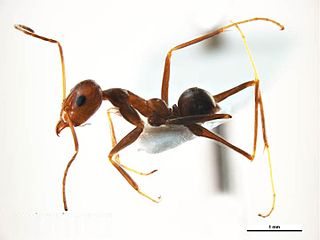
Iridomyrmex is a genus of ants called rainbow ants first described by Austrian entomologist Gustav Mayr in 1862. He placed the genus in the subfamily Dolichoderinae of the family Formicidae. It has 79 described species and five fossil species. Most of these ants are native to Australia; others are found in Asia and Oceania, and they have been introduced to Brazil, New Zealand, and the United Arab Emirates. Fossil species are known from China, France, and the United States.

The meat ant, also known as the gravel ant or southern meat ant, is a species of ant endemic to Australia. A member of the genus Iridomyrmex in the subfamily Dolichoderinae, it was described by British entomologist Frederick Smith in 1858. The meat ant is associated with many common names due to its appearance, nest-building behaviour and abundance, of which its specific name, purpureus, refers to its coloured appearance. It is among the best-known species of ant found throughout Australia; it occurs in almost all states and territories except for Tasmania. Its enormous distribution, aggression and ecological importance have made this ant a dominant species.

Jalmenus ictinus, the Ictinus blue or stencilled hairstreak, is a butterfly of the family Lycaenidae. It is found in Australia in the Australian Capital Territory, New South Wales, Queensland and Victoria.

Jalmenus inous, the Inous blue or varied hairstreak, is a butterfly of the family Lycaenidae. It is endemic to coastal Western Australia.

Jalmenus lithochroa, the lithochroa blue or Waterhouse's hairstreak, is a butterfly of the family Lycaenidae. It is endemic to a small area around Adelaide in South Australia.

Nacaduba biocellata, the double-spotted line blue, is a butterfly of the family Lycaenidae. It is found in Australia, Singapore, the New Hebrides, Sumba and Bali.

Philidris is a genus of ants in the subfamily Dolichoderinae. The genus is known from tropical forests from eastern India to northern Australia. It is similar to the genus Iridomyrmex, from where the type species was transferred from by Shattuck (1992).

Iridomyrmex anceps is an ant species of the genus Iridomyrmex. It has a very large distribution on multiple continents, but it is mainly distributed in northern Australia. Some specimens were found on multiple islands, and some were even found and collected in the United Arab Emirates.

Iridomyrmex cappoinclinus is a species of ant belonging to the genus Iridomyrmex. Native to Australia, they have been mainly studied and observed in the Northern Territory. It was first described by Shattuck back in 1993.
Iridomyrmex azureus is a species of ant in the genus Iridomyrmex. Described by Viehmeyer in 1914, specimens collected have been found in dry habitats in Western Australia and South Australia, and also in New South Wales and the Northern Territory.
Iridomyrmex cuneiceps is a species of ant in the genus Iridomyrmex, endemic to Australia, typically seen in northern inland regions of Western Australia and some remote areas in the Northern Territory. Described in 2011, the ant is medium in size.
Iridomyrmex elongatus is a species of ant in the genus Iridomyrmex, described by Heterick and Shattuck in 2011. Its biology is almost unknown, but the distribution of the ant extends from Western Australia and into the Northern Territory.

Iridomyrmex minor is a species of ant in the genus Iridomyrmex. Described by Forel in 1915, the ant is common in Western Australia, South Australia, Northern Territory and Queensland, and it is unlikely there are existing colonies in more southern Australian states. Nests have been found under bark, and is among the most likely ant to be encountered by the general public.

Iridomyrmex reburrus is a species of ant in the genus Iridomyrmex. Described by Shattuck in 1993, the species is endemic to the northern regions of Australia.
Iridomyrmex roseatus is a species of ant in the genus Iridomyrmex. Described by Heterick and Shattuck in 2011, the species has a northern temperate and tropical distribution in Australia, and can be found in most states, and the habitats of the ant may be similar to the preferences of the Meat ant species.

Iridomyrmex rufoinclinus is a species of ant in the genus Iridomyrmex. Described by Shattuck in 1993, the species is a common ant in the northern regions of Australia in woodland like habitats, and nests can be found on loose soils.

Iridomyrmex rufoniger is a species of ant in the genus Iridomyrmex. It was described by Lowne in 1865. The species is endemic to Australia and introduced to several other countries.
Iridomyrmex setoconus is a species of ant in the genus Iridomyrmex. Described by Shattuck and McMillan in 1998, the species is endemic to Australia, and small populations have only been found in Esperance.
Iridomyrmex trigonoceps is a species of ant in the genus Iridomyrmex. Described by Heterick and Shattuck in 2011, the species is broadly distributed in Western Australia, South Australia and the Northern Territory, but the species is relatively uncommon.












